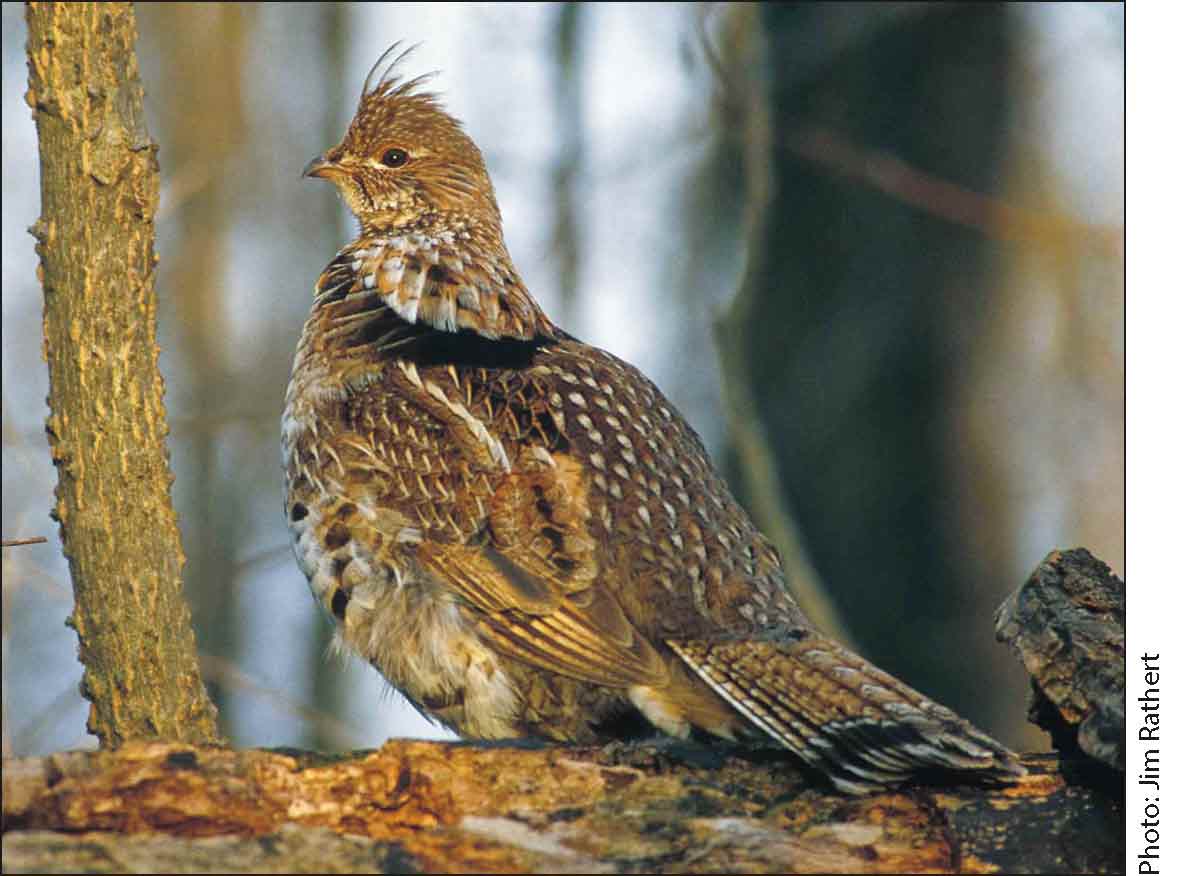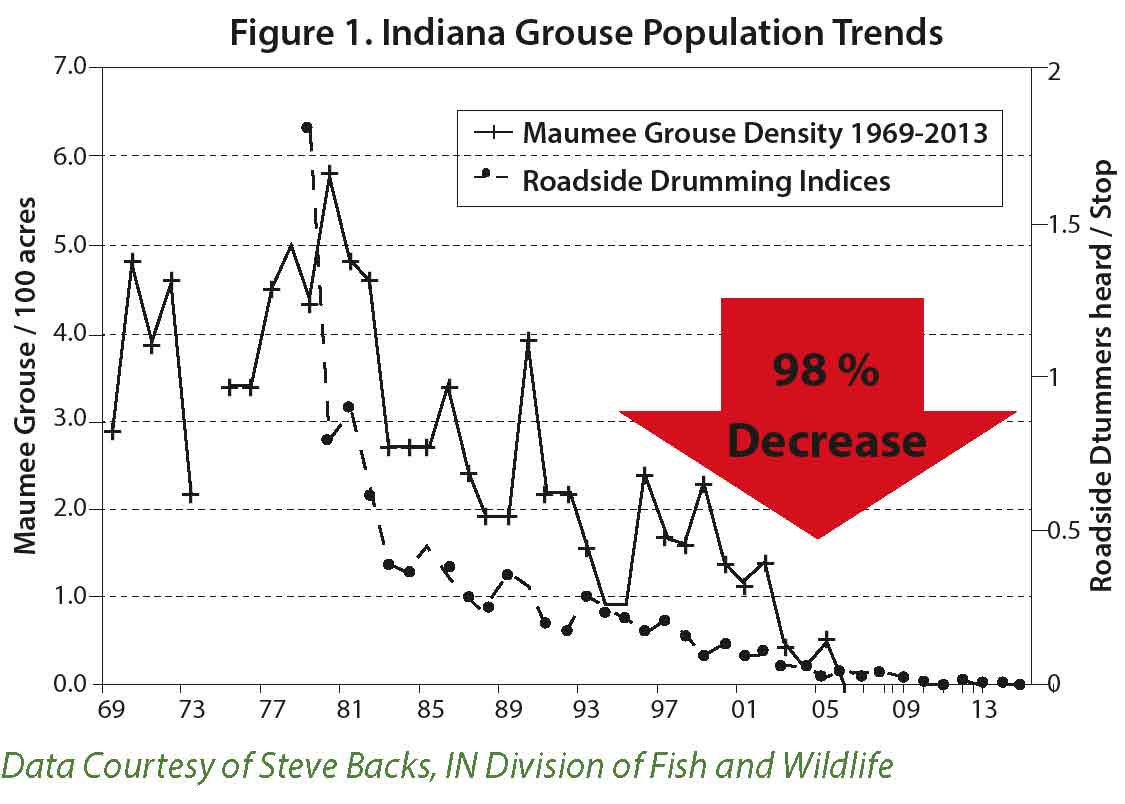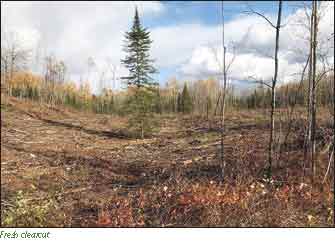Reversing Ruffed Grouse Declines in Indiana
Ruffed grouse used to be present across the Indiana landscape, but now they could be joining the ranks of endangered species listed under the Indiana Nongame and Endangered Species Conservation Act. In October 2018, the Indiana Department of Natural Resources (IDNR) Division of Fish & Wildlife sought input from Ruffed Grouse Society (RGS) to add ruffed grouse to the list of endangered species of birds in Indiana. After reviewing the evidence, biologists at RGS agreed with the proposal and submitted a petition to adopt the Administrative Rule Change. Here’s how this issue all started, how we could reverse its course, and how you could play an important part in that process.
 Background | How We Got Here
Background | How We Got Here
The ruffed grouse’s future in Indiana is far from certain right now, and that’s a terrifying thought for many Hoosiers and upland hunters across the country. This isn’t necessarily a new problem though. There has been a steady decline in grouse numbers for years and biologists have warned about it. But it’s reaching a dangerous fork in the road, past which there may be no return.
There’s a lot of data to support this negative trend. For example, we know that grouse need a diverse habitat with dense seedling to sapling-sized trees (Backs and Castrale 2010). Without it, grouse start to fade away on the landscape. According to the IDNR Wildlife Science Report (2017), the 2017 statewide drumming survey in Indiana reported zero drumming grouse on 14 different roadside routes for the fifth year in a row. Further, only one grouse has been heard over the past seven years during these surveys. The probability of observing a breeding ruffed grouse in a priority survey block has declined by 89% in the past 20 years (Shaw, personal communication). The U.S. Breeding Bird Survey (the most comprehensive nation-wide survey of breeding birds) reported no grouse in Indiana through 2013 (Sauer et al. 2014).
As a result, the Indiana grouse hunting season was suspended in 2015 and ruffed grouse were added to the Indiana list of Species of Special Concern. This is generally the first step in recognizing a potential conservation issue for a species. As mentioned, RGS petitioned to adopt the rule to upgrade that status to state endangered. This rule change may not be heard until January of 2020, and there will be an opportunity for public comment.
Consequences of Habitat Loss
So what is the primary reason behind this rapid decline? As usual, it’s related to habitat. Healthy and diverse forests allow grouse to survive beyond the challenges of predation, disease, or weather anomalies. Early seral habitats (e.g., young forests, age classes 0-20 years) are critical for ruffed grouse for breeding, brood rearing, and winter cover and they’re important for many other declining wildlife species in Indiana as well. Combined with a diverse patchwork of other forest stands and ages, these harvested areas help provide an essential component for grouse.
From 1986 to 2015, the amount of Indiana forests in the 0-20 year age class declined by 68% while mature forests increased significantly (Shaw, personal communication). Unless significant timber harvests of sufficient intensity are conducted on the landscape soon, extirpation (localized extinction) of this species is almost inevitable. What would it take to reverse these trends? At a minimum, Indiana would need 15% young forests (0-20 years old) on the landscape to expect any kind of recovery of the ruffed grouse. Even then, there is a significant lack of a breeding population, so it would likely be a complicated recovery.
Challenges with Forest Management
Unfortunately, there’s a lot of misinformation out there about forest management practices. Many people hear the term “timber harvest” and think “devastation” instead. In reality, ethically sound and science-based timber harvests result in quickly regenerating tree cover. A clearcut area can look messy for a few years, but within a single growing season, they usually re-sprout with dense tree cover. These young forest stands are used by multiple wildlife species (e.g., grouse, deer, turkeys, migratory birds, small mammals, amphibians, etc.) immediately.
Another concern people have is from the recreational or aesthetic side. Mature forests are beautiful – there’s no doubt about it. But as mentioned above, the amount of it in Indiana has increased dramatically since 1986, resulting in an unbalanced and less diverse landscape. There’s no foreseeable shortage of it. Therefore, there is a huge opportunity to restore younger forest stands. Here are just a few benefits from healthy forest management: clean water and air, improvements in recreational opportunities (hunting and non-hunting), additional wildlife watching opportunities, carbon sequestration (important for climate change), and economic development (e.g., forest products).
 Role of Private Landowners
Role of Private Landowners
Did you know that 87% of Indiana’s forested land is privately owned? That means private woodland owners like you have a lot of power to change this situation. Fortunately, there are also many ways you can get involved.
Various agencies (e.g., USDA NRCS, IDNR, etc.) offer numerous programs to help private landowners manage their forestland. After developing a management plan for your property, there are cost share programs and tax incentives to make the decision easier for you.
Consulting foresters can assist landowners with implementing these conservation practices that will help you meet your forest management goals and objectives.
Joining RGS and the Indiana Chapter can keep you involved in the process too. Membership helps you stay connected with other like-minded woodland owners and conservationists, and the various events can keep you updated on this issue and other important public policy decisions.
 If each private woodland owner created young forests on 10-15% of their wooded acreage with each timber harvest, we would be well on our way to bringing back important habitat that’s been missing in Indiana for decades. Will you help?
If each private woodland owner created young forests on 10-15% of their wooded acreage with each timber harvest, we would be well on our way to bringing back important habitat that’s been missing in Indiana for decades. Will you help?
Ryan is a wildlife biologist, hunting mentor, and outdoors writer from Saint Paul, Minnesota. This story was submitted for publication by the Ruffed Grouse Society, www.ruffedgrousesociety.org. RGS is dedicated to preserving our sporting traditions by creating healthy forest habitat for ruffed grouse, American woodcock and other wildlife.
